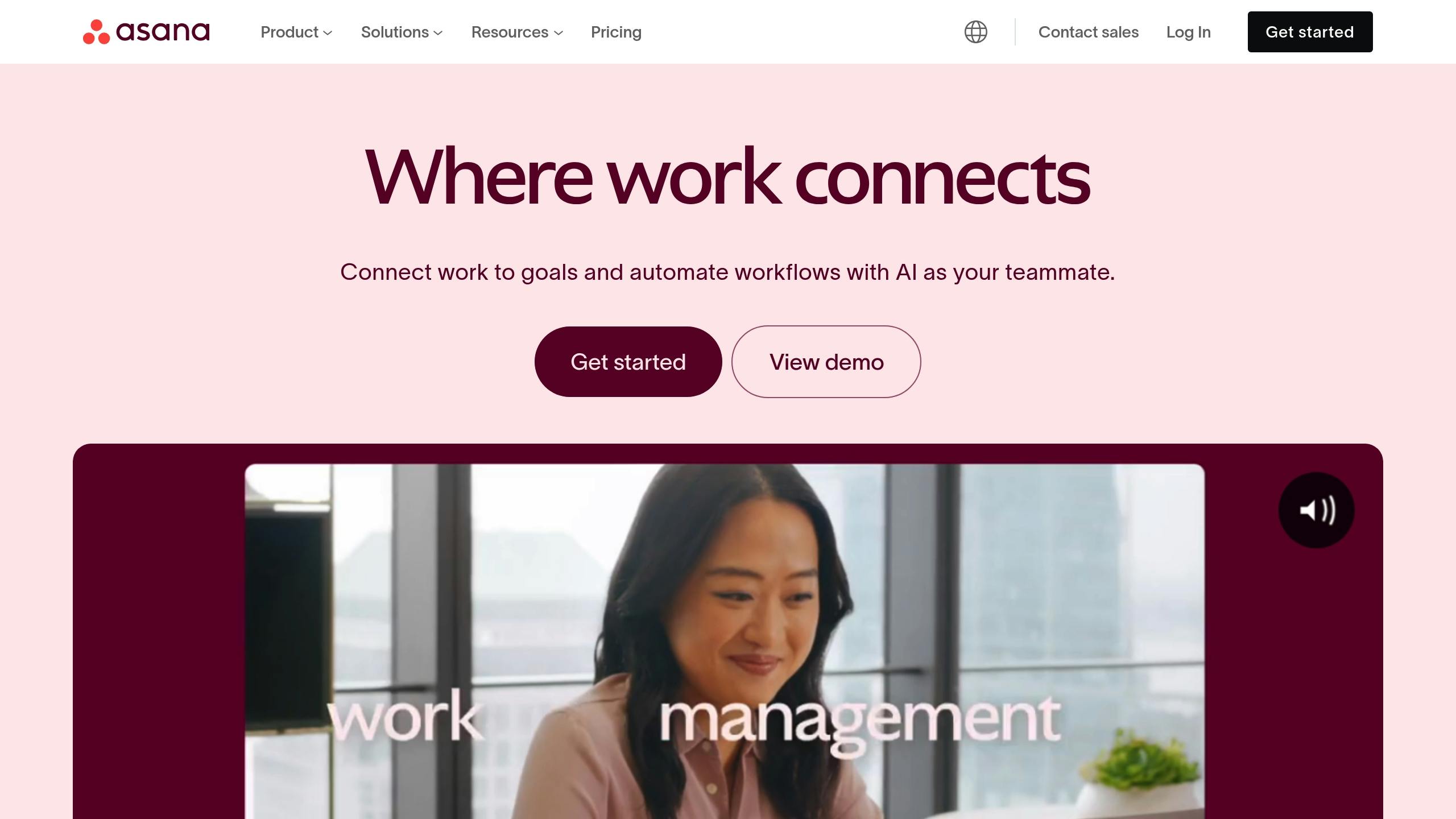Product Team Collaboration: Essential Tools and Best Practices
Explore essential tools and best practices for enhancing collaboration in product teams, tackling communication gaps and tool overload effectively.

Collaboration is critical for product teams, but poor communication and tool overload can lead to project delays and inefficiencies. Here’s how to tackle these issues and boost team performance:
- Top Challenges: Communication gaps, information silos, and misaligned priorities disrupt workflows.
- AI-Powered Solutions: Automate 45% of repetitive tasks, improve decision-making, and enhance communication.
- Best Tools:
- Asana: Smart task prioritization for mid-size teams.
- Jira: Sprint planning and bug detection for agile teams.
- BuildBetter: Real-time capacity analysis for complex projects.
- Effective Methods:
- Set clear communication rules (e.g., Slack for urgent updates, project tools for daily tasks).
- Use data-driven decisions to improve outcomes by 23%.
- Consolidate tools to avoid fatigue and save costs.
Focus on integrating AI tools, refining workflows, and prioritizing security to streamline collaboration and achieve faster results.
Best Project Management Software for 2025? Motion vs Asana vs ClickUp vs Monday vs Notion

Top Collaboration Tools for Product Teams
Modern tools powered by AI have reshaped how product teams collaborate, falling into three main categories:
AI Project Management Software
AI is changing the way teams manage projects, making task assignments and planning more efficient. For example, BuildBetter uses machine learning to assign tasks based on real-time capacity.
| Tool | Key AI Features | Best For |
|---|---|---|
| Asana | Predicts workloads, smart task prioritization | Mid-size teams |
| Jira | AI for sprint planning, automated bug detection | Agile teams |
| BuildBetter | Capacity analysis with machine learning | Complex projects |
Team Communication Tools
Communication platforms have become vital for hybrid and remote teams. For instance, Grammarly Business helps teams review documents 40% faster with AI-powered suggestions.
AI-enhanced integrations between tools like Jira and Confluence can cut manual status updates by 45%.
"Teams using integrated tools like Jira and Confluence saw a 30% increase in project delivery speed" - Atlassian Report
Another standout is Klaxoon, which uses AI to identify task dependencies during design sprints and planning sessions. These tools simplify communication and set the stage for more efficient workflows.
Work Automation Tools
Automation tools handle repetitive tasks through intelligent workflows, saving time and effort. For example, Moveworks clients report a 65% drop in IT support resolution times. Features like GDPR-compliant document automation and custom report generation make these tools indispensable for many teams.
Team Collaboration Methods That Work
While tools are essential, the right methods ensure they’re used effectively.
Setting Communication Rules
Clear communication rules can improve team efficiency and reduce misunderstandings. Research shows that structured communication protocols can increase talent retention by 4.5x . Here’s a simple breakdown of how to organize communication:
| Communication Type | Primary Channel | Response Time |
|---|---|---|
| Urgent Updates | Slack/Teams | Within 1 hour |
| Project Updates | Project Management Tools | Within 24 hours |
| Strategic Discussions | Scheduled Meetings | Weekly/Bi-weekly |
| Documentation | Documentation Platforms | Updated within 48 hours |
Many teams find success by creating communication charters that outline these protocols . These guidelines help reduce confusion and make collaboration smoother.
Using Data to Make Decisions
Data-driven decisions are becoming a cornerstone for modern teams. Studies reveal that teams using data analytics are 23% more likely to exceed their goals [6].
"When we implemented regular data review sessions, our feature adoption rates increased by 28%, and our decision-making time decreased by 40%. The key was creating custom visualizations that made complex data accessible." - Alex Wong, Senior Product Manager at Atlassian [6]
Teams often rely on a mix of tools to gather and analyze data, including:
- User behavior analytics from platforms like Amplitude
- Customer feedback collected through tools like UserVoice
- A/B testing results from services such as Optimizely
- AI-powered analytics for deeper insights
These tools, combined with regular data reviews, help teams make faster, more informed decisions.
Preventing Tool Overload
Using too many tools can overwhelm teams. In fact, 71% of product managers report feeling fatigued when their teams juggle 3–5 collaboration tools daily . To address this, companies are streamlining their tech stacks.
For example, Shopify’s 2025 tool consolidation led to:
- A 25% boost in team productivity
- $180,000 saved annually on software licenses
- A 40% cut in onboarding time
This success was largely due to quarterly audits that used AI-powered analytics to identify underutilized tools. By focusing on integration and core functionalities, Shopify reduced unnecessary complexity and improved team performance.
Solving Team Collaboration Issues
Collaboration challenges can persist despite implementing effective methods, and these require specific solutions. Modern product teams often face intricate issues, with 86% of workplace failures linked to poor communication.
Connecting Separate Teams
Bringing together cross-functional teams demands not just the right tools but also a thoughtful strategy. AI-driven platforms now simplify cross-team collaboration by automating data integration, tackling the silos highlighted in Common Product Team Problems. These platforms create shared workspaces that seamlessly integrate with tools like Slack and Jira, ensuring smoother workflows.
AI and Human Decision-Making
The best teams blend AI-driven insights with human expertise. For example, Microsoft leveraged AI analytics in project management, leading to a 20% boost in delivery accuracy and a 15% cut in development cycle times. Similarly, IDEO's approach to product development combines AI insights with human-focused design, resulting in a 30% increase in new product features.
Data Security in Team Tools
As teams rely more on connected tools, securing sensitive data is critical. In 2023, 67% of companies reported data breaches through collaboration tools. To address this, modern platforms incorporate AI-driven anomaly detection and prioritize security through:
- Role-based access combined with multi-factor authentication
- End-to-end encryption for all data
- Regular vulnerability assessments conducted quarterly
Conclusion
AI-driven methods have reshaped how product teams collaborate. According to recent data, teams using AI-powered collaboration platforms have cut their time-to-market by 25% [6]. This shows how these tools can directly impact productivity and efficiency.
Choosing the Right Tools
Selecting the right tools is crucial to addressing challenges like communication breakdowns, tool overload, and security concerns. These tools should align with your team's workflows and priorities. Research shows that 78% of product teams experienced more accurate decision-making after adopting AI-based analytics tools . This underscores the potential of such solutions.
When choosing tools, focus on these key aspects:
- Integration Capabilities: Tools should connect effortlessly with platforms like Zoom, Slack, and Jira to streamline workflows.
- AI Features: Look for tools that improve productivity with features like automated documentation and smart workflow management.
- Security and Compliance: Safeguard your data with tools that prioritize security without disrupting collaboration .
Next Steps for Teams
To improve collaboration, product teams should aim for measurable progress. Use this framework to guide implementation:
- Pinpoint workflow bottlenecks and challenges.
- Roll out new tools gradually, starting with essential features.
- Monitor user adoption and gather feedback.
- Refine processes based on performance data.
FAQs
How can team communication be improved?
Improving team communication involves refining tools, setting clear protocols, and addressing common challenges. Here’s how you can make it work:
1. Set Up Clear Communication Channels
Define specific channels for different purposes to improve information flow. For example, a structured approach led to a 35% boost in productivity and a 22% drop in stress levels for one team.
2. Use a Mix of Communication Methods
Combine real-time and delayed communication to suit different needs:
| Communication Type | Purpose | Example Tools |
|---|---|---|
| Synchronous | For urgent or complex discussions | Zoom, Microsoft Teams |
| Asynchronous | For documentation or updates that aren’t time-sensitive | Slack, project wikis |
| Broadcast | For company-wide announcements | Email, shared documents |
3. Incorporate AI-Powered Tools
Modern AI tools can take team communication to the next level by offering:
- Automated meeting summaries
- Real-time language translation
- Analysis of communication patterns , which can highlight issues like information silos
To make the most of these tools, ensure regular feedback loops so they support - not replace - human collaboration.